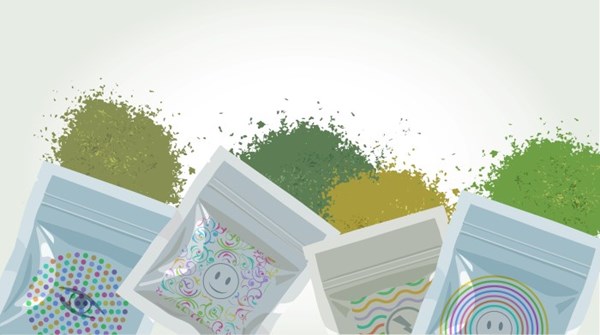Marijuana, THC (tetrahydrocannabinol), and CBD (cannabidiol) products are becoming increasingly popularized and legalized in our society. With the proliferation of these products’ use also comes accidental ingestion and fraudulent product distribution.
Types of THCs widely used are THC-A, THC-V, Delta-8 THC, and Delta-9 THC (most common form). All these variations have different intended effects when ingested and have different natural concentrations in the cannabis sativa plant. Delta-8 THC and Delta-9 THCs’ effects include euphoria (feeling “high”), relaxation, and pain relief by binding to the cannabinoid receptor (CB1). These effects are highly desired by cannabis consumers. Delta-9 THC is in higher concentration than Delta-8 THC in naturally grown cannabis. However, hemp-derived CBD can be manufactured to isolate and concentrate Delta-8 THC.1 This manufacturing process can be dangerous, and emergency physicians need to know the risks this substance poses.
Because these Delta-8 THC products are synthesized from hemp products and not the cannabis plant, they can be manufactured and sold in states where marijuana is still illegal. The 2018 Farm Bill legalized hemp products containing less than 0.3% Delta-9 THC. This means there is ambiguity at the federal level for products containing higher amounts of Delta-8 THC, as long as they don’t have more than 0.3% Delta-9 THC based on dry weight. It is claimed that Delta-8 THC is legal at the federal level due to this chemical loophole.2 Manufacturers have become savvy in that they can synthesize hemp with the maximum legal amount of Delta-9 THC and dramatically increase the amount of Delta-8 THC. This makes for a product that has very potent effects. Manufacturers can also isolate Delta-8 THC and make very potent products, as there are no laws limiting the quantity of Delta-8 THC a product can have. The Drug Enforcement Administration (DEA) has proposed a new rule to indirectly classify Delta-8 THC as a Schedule 1 drug, which would make it illegal. This has yet to be finalized.1
According to the U.S. Cannabis Council, manufacturing of Delta-8 THC can occur in uncontrolled or unsanitary settings, which leads to potential contamination. Some contaminants include other cannabinoids, Delta-9 THC, heavy metals, lead, and mercury.3 These Delta-8 THC products can be purchased easily online or in gas stations where the age limits on products may not be fully enforced. Delta-8 THC is also packaged into candies, brownies, and gummies where the final colors can be made from unsafe household chemicals.3 These treats look innocent and enticing to children and pets, which leads to accidental ingestion and overdose. These Delta-8 THC products can cause tachycardia, anxiety, dizziness, vomiting, hallucinations, discoordination, memory loss, delayed reaction time, loss of consciousness, or even death. Additional research is needed to determine long-term health consequences of these products.
Delta-8 THC has not been evaluated or approved by the Food and Drug Administration (FDA). For this reason, varying amounts of the substance may be present in a product being purchased. Some products are labeled as therapeutic or medicinal. This is entirely unsubstantiated by any research or data and is problematic for many reasons. People who prefer homeopathic remedies for serious diseases may choose to use these non-FDA-approved products instead of prescribed pharmaceuticals, which puts them at risk of morbidity or mortality from their disease. This deceptive marketing is illegal and a public health crisis.
Emergency physicians should be aware of many things regarding Delta-8 THC. Cannabis detected in a standard urine drug screen looks for Delta-9 THC. Delta-8 THC by itself will not generate a positive UDS. It is also indeterminate how long Delta-8 THC remains in urine, hair, or blood for analysis.
Also, emergency physicians need to be aware of Delta-8 THC when assessing an undifferentiated comatose patient. According to the National Poison Control Center, there were 2,362 Delta-8 THC exposures between Jan. 1, 2021, and Feb. 28, 2022. Of these exposures, 40% were unintentional ingestions. Of those, 82% were in the pediatric population. Eight percent required admission to a critical care unit. In one pediatric case, the patient coded and died.3
In the new world of synthetic and man-made illicit substances, emergency physicians truly need to be more astute than ever to properly diagnose, treat, and educate their patients.
To learn even more about Delta-8 THC, head over to EMRA*Cast for Dr. Brittany Ladson’s podcast interview with Dr. Kyle Duke.
References
- Cannabis Regulatory Agency. (n.d.). Delta-8 information. SOM - State of Michigan. Retrieved May 1, 2023.
- Cleveland Clinic. (2023, March 3). What you need to know about delta-8. Cleveland Clinic. Retrieved May 1, 2023.
- FDA. (2022, May 4). 5 things to know about delta-8 tetrahydrocannabinol – delta-8 THC. U.S. Food and Drug Administration. Retrieved May 1, 2023.



